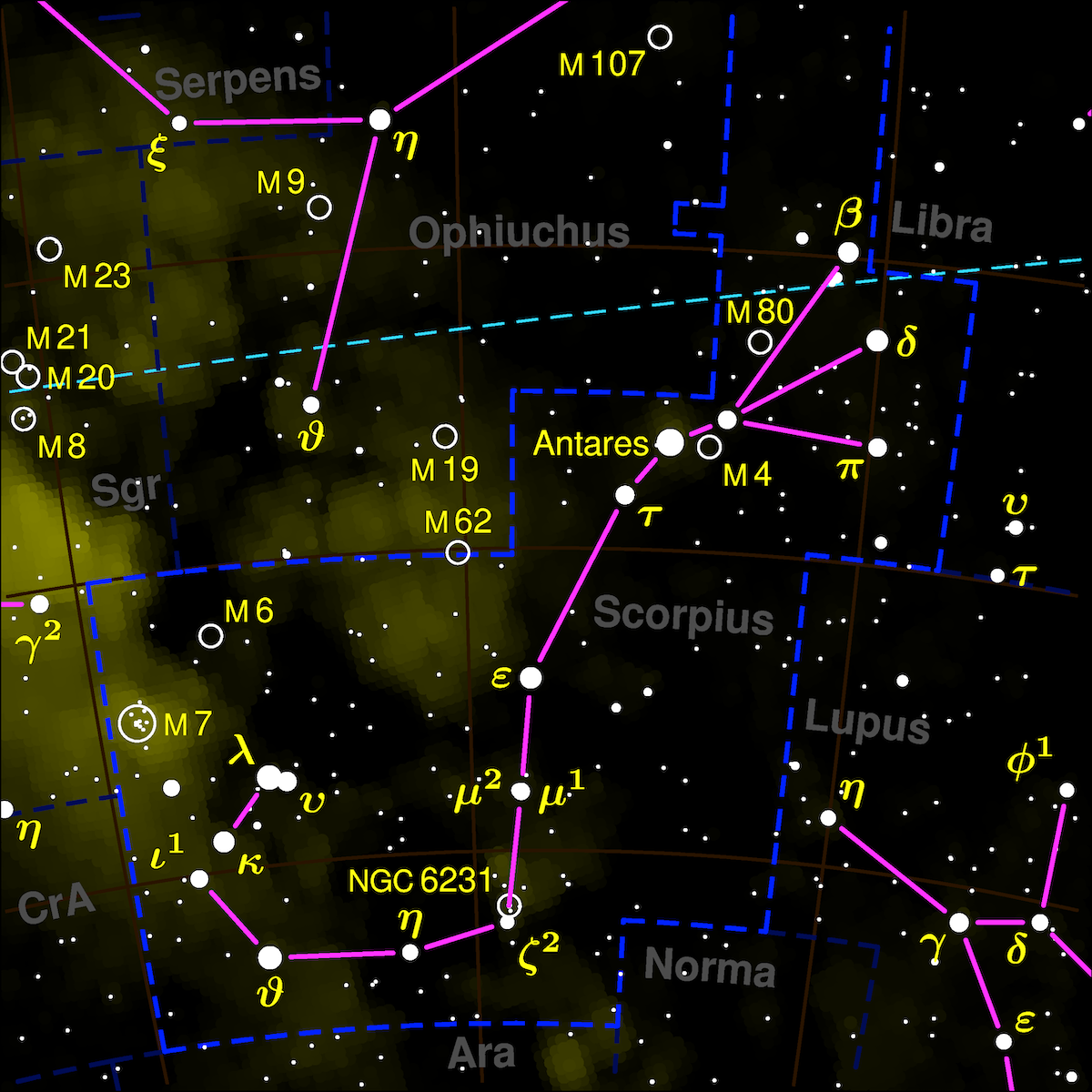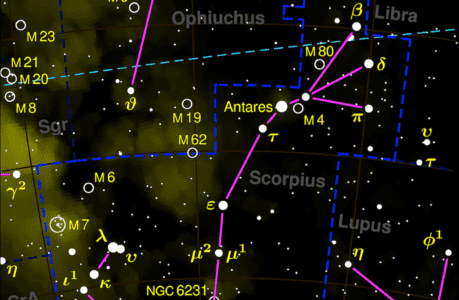The Scorpius constellation is one of the most fascinating and mesmerising constellations in the night sky. Located in the southern hemisphere, it is visible from many parts of the world, including Ireland. With its distinctive shape, it has been the subject of myths and legends for thousands of years.
In this article, we will delve into the wonders of the Scorpius constellation, its mythology, stars, and how to view it from Ireland.
The Mythology of Scorpius
Scorpius is a constellation with a rich history of mythology. According to Greek mythology, the constellation represents the scorpion that killed Orion, a great hunter. The story goes that Orion boasted to Artemis, the goddess of hunting, that he could kill all the animals on Earth. In response, Gaia, the Earth goddess, sent a giant scorpion to kill Orion.
The two battled fiercely until the scorpion eventually won and killed Orion. Zeus then placed both the scorpion and Orion in the heavens as constellations.
The Stars of Scorpius
The Scorpius constellation is home to several bright stars, including Antares, the brightest star in the constellation. Antares is a red supergiant star, 700 times larger than our sun and 10,000 times brighter.
Another notable star in the constellation is Shaula, the second brightest star. It is a blue-white star that is 20,000 times brighter than our sun and approximately 26 times larger.
Scorpius also contains several other stars, including Dschubba, Graffias, and Jabbah, all of which are easily visible in the night sky.
How to View Scorpius from Ireland
Scorpius is a southern hemisphere constellation, which means it is not visible from Ireland all year round. The best time to view Scorpius from Ireland is during the summer months, between June and August.
During this period, Scorpius is visible in the southern part of the sky, low on the horizon. To view Scorpius, you should find a location with an unobstructed view of the southern horizon.
The best time to view Scorpius is during the late evening and early morning hours when the constellation is at its highest point in the sky. You can also use a star chart or a stargazing app to locate Scorpius and identify its stars and features.
Final Thoughts
The Scorpius constellation is a remarkable and fascinating celestial display. Its mythology, stars, and unique shape make it a must-see for stargazers and astronomy enthusiasts. From Ireland, you can view Scorpius during the summer months, providing you with a chance to witness its beauty and magnificence firsthand.
Whether you’re a seasoned stargazer or a newcomer to astronomy, Scorpius is a constellation that is well worth exploring. So, grab your telescope or binoculars and head outside to enjoy the wonder and beauty of the Scorpius constellation.
How can I see the constellation of Scorpius from Ireland?
To see the constellation of Scorpius from Ireland, you need to wait until the summer months between June and August when the constellation is visible in the southern part of the sky. During this period, Scorpius will be low on the horizon and can be seen best during the late evening and early morning hours when the constellation is at its highest point in the sky.
To locate Scorpius, you should find a location with an unobstructed view of the southern horizon. Away from cities and towns is usually the best choice to avoid light pollution.
If you’re new to stargazing, you may want to use a stargazing app or a star chart to help you locate Scorpius in the night sky. Once you have identified Scorpius, you can try to pick out some of its notable stars, such as Antares, the brightest star in the constellation, or Shaula, the second brightest star.
It’s important to note that Scorpius is a southern hemisphere constellation, which means that it’s not visible from Ireland all year round. So, make sure to plan your stargazing during the summer months when Scorpius is visible in the Irish sky.
The mythology of the constellation of Scorpius
The mythology of the constellation of Scorpius is steeped in ancient Greek lore. In Greek mythology, Scorpius represents the scorpion that killed Orion, a legendary hunter. The story goes that Orion boasted to Artemis, the goddess of hunting, that he could kill all the animals on Earth. In response, Gaia, the Earth goddess, sent a giant scorpion to kill Orion.
The scorpion and Orion battled fiercely, but the scorpion eventually won and killed Orion. Zeus, the king of the gods, placed both the scorpion and Orion in the heavens as constellations.
The placement of Scorpius near Orion in the sky is no coincidence. According to the myth, Zeus placed the two constellations at opposite ends of the sky to prevent any further conflict between the scorpion and Orion. In some versions of the myth, Scorpius is said to be guarding the entrance to the underworld.
Interestingly, Scorpius is not the only constellation associated with scorpions in mythology. The Babylonians also had a scorpion constellation, which they called MUL.GIR.TAB, and the ancient Egyptians had a scorpion goddess, Serket.
In addition to its Greek mythology, Scorpius also has ties to other cultures. In Hindu mythology, the constellation is associated with Jyeshtha, a goddess of misfortune and calamity. In ancient Babylon, the constellation was known as Girtab, which means “the scorpion”. The ancient Maya also had a scorpion constellation, which they called Sip.
Overall, the mythology of the constellation of Scorpius has deep roots in ancient cultures and is a fascinating reminder of how our ancestors looked up at the same sky and saw stories and legends in the stars.
The Stars in the constellation of Scorpius
The constellation of Scorpius is home to several bright and notable stars that have captured the attention of stargazers and astronomers throughout history. Let’s take a closer look at some of the stars in Scorpius:
- Antares: Antares is the brightest star in Scorpius and is also one of the brightest stars in the night sky. It is a red supergiant star that is approximately 700 times larger than our Sun and 10,000 times brighter. Antares’ reddish colour makes it easy to spot in the sky.
- Shaula: Shaula is the second brightest star in Scorpius and is a blue-white star that is approximately 26 times larger than our Sun and 20,000 times brighter. Its name comes from the Arabic word for “the raised tail.”
- Dschubba: Dschubba is a blue-white star located in the “head” of the scorpion in Scorpius. It is approximately 3,000 light-years away from Earth and is believed to be a binary star system.
- Graffias: Graffias is a triple-star system located in the “stinger” of the scorpion. It is composed of three stars that orbit each other and is approximately 530 light-years away from Earth.
- Jabbah: Jabbah is a double-star system located in the “claws” of the scorpion. It is approximately 445 light-years away from Earth and is composed of two stars that orbit each other.
In addition to these notable stars, Scorpius also contains several other stars that are visible to the naked eye. Together, they form the distinct shape of a scorpion that has captured the imaginations of people throughout history.
Deep sky objects visible in the Constellation of Scorpius
The constellation of Scorpius is home to several fascinating deep sky objects that are popular among stargazers and astronomers. Here are some of the most notable deep sky objects in Scorpius:
Messier 4 is a globular cluster located near the “stinger” of the scorpion. It is approximately 7,200 light-years away from Earth and contains over 100,000 stars. Messier 4 is one of the closest globular clusters to Earth and is visible to the naked eye under dark skies.
Messier 80 is another globular cluster located near the “stinger” of the scorpion. It is approximately 28,000 light-years away from Earth and contains over 150,000 stars. Messier 80 is older than most globular clusters and is believed to be around 12.5 billion years old.
NGC 6231 is an open star cluster located in the “tail” of the scorpion. It is approximately 5,200 light-years away from Earth and contains around 100 stars. NGC 6231 is one of the youngest open clusters in our galaxy and is believed to be only 3.2 million years old.
Scorpius X-1 is a binary star system located in the “stinger” of the scorpion. It is a strong X-ray source and was the first X-ray source discovered in the constellation of Scorpius. Scorpius X-1 is a black hole with a mass estimated to be around 10-15 times that of our Sun.
IC 4628 is a diffuse emission nebula located near the “tail” of the scorpion. It is approximately 6,000 light-years away from Earth and is notable for its bright colours and interesting shapes. IC 4628 is an active star-forming region and contains several hot, young stars.
These deep sky objects, along with the stars in the constellation of Scorpius, make it a fascinating and rewarding constellation to explore with a telescope or binoculars.

